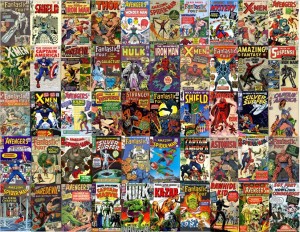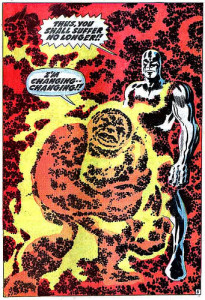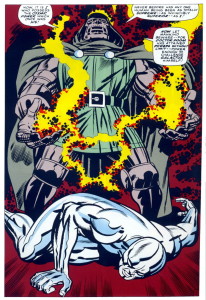This was originally written on August 28th, 2015. Excuse the delay in publishing. There are some odd formatting ticks in this article. Either don’t know how or don’t feel like fixing them.
Today is Jack Kirby’s birthday (as well as our wonderful Secretary Matt’s). Everyone with a remote interest in Marvel, superheroes and comics as an art form should be intimately familiar with this name.
The man was born Jacob Kurtzberg on the Lower East Side of New York in 1917. Jack was Jewish, like the majority of prominent early cartoonists. He got his first break in the industry working with writer Joe Simon throughout the 1940s and ’50s. This was interrupted by Kirby getting drafted for World War II, in which he was tasked  with going ahead of friendly lines and drawing reconnaissance maps. Simon and Kirby’s most famous creation of that period was Captain America for Timely Comics, what we know today as Marvel Comics, who famously punched Adolf Hitler in the face on his first cover, nearly an entire year before the Japanese attack on Pearl Harbor. At the time, many powerful New Yorkers were supporters of the Nazi regime. Granted, to cut them a bit of slack, most of the Jewish Holocaust was not known of at that point in time. Many sent angry letters and protested outside the Timely offices, prompting the mayor to provide police protection. The comic was selling a million copies an issue, having an even greater circulation than the magazine Time. During this era, the duo also did work for National Comics (DC) on Sandman and practically created the “kid gang” genre which consisted of orphans running around doing things like delivering newspapers and helping fight the Nazis. They also created the first comic issue that was solely dedicated to Captain Marvel (aka Shazam) stories for Fawcett Comics.
with going ahead of friendly lines and drawing reconnaissance maps. Simon and Kirby’s most famous creation of that period was Captain America for Timely Comics, what we know today as Marvel Comics, who famously punched Adolf Hitler in the face on his first cover, nearly an entire year before the Japanese attack on Pearl Harbor. At the time, many powerful New Yorkers were supporters of the Nazi regime. Granted, to cut them a bit of slack, most of the Jewish Holocaust was not known of at that point in time. Many sent angry letters and protested outside the Timely offices, prompting the mayor to provide police protection. The comic was selling a million copies an issue, having an even greater circulation than the magazine Time. During this era, the duo also did work for National Comics (DC) on Sandman and practically created the “kid gang” genre which consisted of orphans running around doing things like delivering newspapers and helping fight the Nazis. They also created the first comic issue that was solely dedicated to Captain Marvel (aka Shazam) stories for Fawcett Comics.
 For decades people have thought of comics as being primarily about superheroes, but prior to the establishment of the Comics Code Authority many genres flourished. Jack Kirby innovated in every single one of them. One of his most notable works is his extensive romance comics oeuvre, which were popular with teenage girls at the time. Simon and Kirby also did tons of science fiction, western, crime and horror stories. Their relationship ended amicably when Simon decided to go into advertising, which left Kirby floating around doing freelance work wherever he could get it. At least until he would end up working somewhere he had earlier, achieving his creative peak and cementing himself as a legend in the process.
For decades people have thought of comics as being primarily about superheroes, but prior to the establishment of the Comics Code Authority many genres flourished. Jack Kirby innovated in every single one of them. One of his most notable works is his extensive romance comics oeuvre, which were popular with teenage girls at the time. Simon and Kirby also did tons of science fiction, western, crime and horror stories. Their relationship ended amicably when Simon decided to go into advertising, which left Kirby floating around doing freelance work wherever he could get it. At least until he would end up working somewhere he had earlier, achieving his creative peak and cementing himself as a legend in the process.
That place in question would of course be  Marvel Comics, at the time known as Atlas Comics. He forged an incredibly fruitful creative relationship with one Stanley Lieber (Stan Lee). They worked together on titles like Tales to Astonish, Tales of Suspense, Journey into Mystery and Strange Tales. Most of these were over the top, twist ending stories with tinges of science fiction and horror, usually involving aliens, robots or giant monsters. They were pretty much cashing in on Godzilla and King Kong parallels.
Marvel Comics, at the time known as Atlas Comics. He forged an incredibly fruitful creative relationship with one Stanley Lieber (Stan Lee). They worked together on titles like Tales to Astonish, Tales of Suspense, Journey into Mystery and Strange Tales. Most of these were over the top, twist ending stories with tinges of science fiction and horror, usually involving aliens, robots or giant monsters. They were pretty much cashing in on Godzilla and King Kong parallels.
November 1961, Fantastic Four #1 hits the shelves and revolutionizes an entire industry and popular culture as a whole. The story (likely a myth) goes that Martin
Goodman, the publisher of Marvel was out golfing with Jack Liebowitz, the owner of DC. Liebowitz bragged about the success his company was seeing with the  recently launched Justice League of America. Goodman came back to the offices and asked Stan Lee to print him some of that superhero money. Lee was harboring aspirations of becoming the next great American writer. Rather than Jacob Kurtzberg, who changed his name to sound more all-American (translation: less Jewish), Stanley Lieber used a pseudonym so that his “immature” and “pedestrian” comics work would not soil his eventual epic novel. One can imagine being tasked to write about men in bright colorful tights would make such a man feel a certain way. On suggestion from his wife Lee set forth with the mission to, for just once, write a comic story that he himself, in all his snobbish glory, could enjoy reading. He planned to write up his resignation letter after it hit the newsstands. The issue amazed its audience and played a major part in jumpstarting what is referred to as the Silver Age of Comic Books (though worth noting the start of the Silver Age is usually noted as Showcase #4, the debut of Barry Allen, the second Flash).
recently launched Justice League of America. Goodman came back to the offices and asked Stan Lee to print him some of that superhero money. Lee was harboring aspirations of becoming the next great American writer. Rather than Jacob Kurtzberg, who changed his name to sound more all-American (translation: less Jewish), Stanley Lieber used a pseudonym so that his “immature” and “pedestrian” comics work would not soil his eventual epic novel. One can imagine being tasked to write about men in bright colorful tights would make such a man feel a certain way. On suggestion from his wife Lee set forth with the mission to, for just once, write a comic story that he himself, in all his snobbish glory, could enjoy reading. He planned to write up his resignation letter after it hit the newsstands. The issue amazed its audience and played a major part in jumpstarting what is referred to as the Silver Age of Comic Books (though worth noting the start of the Silver Age is usually noted as Showcase #4, the debut of Barry Allen, the second Flash).
Lee and Kirby, among other men and women like Steve Ditko, Don Heck, John and Sal Buscema, Roy Thomas, Gene Colan, John Romita, Joe Sinnott, Marie Severin, and Jim Steranko (it’s hard to stop the list when every potential entry is such a legend) would go on to create blockbuster superhero after superhero. There was a stark difference between the Marvel Universe and its contemporaries. Peter Parker was a dorky kid living in Queens, New York not the fabricated Metropolis or Gotham. He dealt with insecurities and pressures steeped in reality. Iron Man traded bullets with the Viet Cong, Reed Richards stared down Communist astronauts. Superman stories of the time still involved Jimmy Olsen getting tricked into marrying a gorilla. This wasn’t so much escapist entertainment as much as it was truly connecting with the characters on the page. The bizarre blend of Stan’s soap opera melodrama dialogue and Jack’s dynamic, often psychedelic art struck a major chord. Spider-Man and the Hulk were listed alongside Bob Dylan and JFK as American heroes. Dr. Strange sold most of its copies to college students, whereas Batman, the “dark” knight, was still being primarily read by ten year olds.
Jack Kirby can be credited with so much of the Marvel pantheon. Everyone under the sun knows Stan Lee, and he is a genuine legend, but Kirby pretty much did all the heavy lifting. Lee invented the “Marvel method” of writing, which involves laying out the basic story in a paragraph or bullets. The artist would then ostensibly create the actual plot through their cartooning. This left Lee with the job of simply going back in and writing dialogue and captions to match the panels. The entire Marvel style was based on Kirby’s look, or at least other artists would try their damnedest to imitate the master. He would even design costumes for characters and sketch layouts for stories he wouldn’t go on to pencil.
Take a deep breath. Jack Kirby created/designed the Fantastic Four, Dr. Doom, Galactus, Silver Surfer, the Skrulls, the Kree, the Inhumans, Black Panther, Ant-Man, Hulk, Spider-Man (a touchy one, as Kirby did the initial sketch, then Steve Ditko redid and finalized the design), Thor, Loki, Iron Man, Nick Fury and S.H.I.E.L.D, the original five X-Men, Professor X, Magneto, Juggernaut, the Sentinels, M.O.D.O.K, H.Y.D.R.A, Kang, Quicksilver, Scarlet Witch-I could go on and on and on here. All of this brilliant work falls within the short span of 9 years at the company.
Kirby left Marvel in 1970 due to a combination of what he saw as too little creative control and too little money for his immense work. He took his talents to rival DC and promptly created The Fourth World, a legendary meta series depicting wars between races of gods, oh and Jimmy Olsen. For the villain of his epic saga, Kirby created Darkseid (who Jim Starlin would later ripoff for Thanos back over at Marvel three years later). His other notable creations at DC in this era include O.M.A.C, Kamandi and Etrigan the Demon.
 Once again, he left DC due to creative differences (yes there is a pattern here and it is a constant in the industry) and came back to Marvel where he did some Captain America and some Black Panther. At this point, Jack was hailed by the entire industry as a living legend, and Marvel was willing to let him create such crazy concepts as Machine Man, Devil Dinosaur and the Eternals. During this tenure at Marvel he also attempted to adapt Stanley Kubrick and Arthur C. Clarke’s 2001: A Space Odyssey to the comics medium. Another highlight of Kirby’s career around this time is his role creating the concept art for Argo, the fake film used as a cover by the C.I.A. to rescue American citizens in the Iranian hostage crisis in 1979.
Once again, he left DC due to creative differences (yes there is a pattern here and it is a constant in the industry) and came back to Marvel where he did some Captain America and some Black Panther. At this point, Jack was hailed by the entire industry as a living legend, and Marvel was willing to let him create such crazy concepts as Machine Man, Devil Dinosaur and the Eternals. During this tenure at Marvel he also attempted to adapt Stanley Kubrick and Arthur C. Clarke’s 2001: A Space Odyssey to the comics medium. Another highlight of Kirby’s career around this time is his role creating the concept art for Argo, the fake film used as a cover by the C.I.A. to rescue American citizens in the Iranian hostage crisis in 1979.
In his later years, Kirby was one of the first crusaders for creator’s rights in the 1980s, notably ten years before the exodus of artists from Marvel to form Image comics. One of Kirby’s later projects was the satirical Destroyer Duck with Steve Gerber, the creator of Howard the Duck. The title existed to raise funds to pay Gerber’s legal fees from fighting Marvel in court over ownership of his characters. The story involves Duke Duck’s friend “The Little Guy” getting exploited and killed by “Godcorp.”
Besides the sheer quantity and cultural significance of his creations, Jack Kirby is admired for the countless innovations he made in the medium and specific aspects of his style. Kirby was among the first in the medium to experiment with collage. It’s said he would request that guests to his house bring newspapers and magazines, in case they may prove useful for a future collage. However it should not be understated, Kirby was just as famous for his quantity. He was famously able to produce over four pages a day, a feat unheard of in today’s landscape of frequent fill-in artists and delays.
Something every Kirby fan loves is the “Kirby krackle.” The Kirby krackle is arguably his most signature element in his work, and is used for everything from explosions, smoke, any kind of energy and simply outer space. I really have no clue how to clearly explain the krackle, so let’s see what a philosophy professor from Rice thinks about it-
“For Kirby, the human body is a manifestation or crystallization of finally inexplicable energies-a superbody. What Mesmer called animal magnetism, Reichenbach knew as the blue od, and Reich saw as a radiating blue cosmic orgone becomes in Jack Kirby a trademark energetics signaled by ‘burst lines’ and a unique energy field of black, blobby dots that has come to be affectionately known as the ‘Kirby Krackle.’ The final result was a vision of the human being as a body of frozen energy that, like an atomic bomb, could be released with stunning effects, for good or for evil. These metaphysical energies, I want to suggest constitute the secret Source of Kirby’s art” (Jeffrey J. Kripal)
Yeah, I’m having a bit of trouble understanding what the hell that means. The krackle is cool. ‘Nuff said. How about I just stick some examples here, that would work.
Jack Kirby’s influence reaches all corners of comics. Most of the Silver Age greats owe debt to Kirby, simply because everyone else was instructed to revolve around his style. Jim Steranko, Neal Adams and many others developed themselves while trying to mirror Kirby. When Mark Waid and Mike Wieringo were working on their celebrated Fantastic Four run, a story included the four meeting “God.” This god turned out to of course be Jack Kirby and his pencil, dictating the world of the Marvel Universe on his drawing table. It’s a great tribute and instance of metafiction. The are certain modern artists like Tom Scioli, whose art can be directly linked to the genetics Kirby created in the industry.
I think many would agree that Jack Kirby is one of the most influential and important figures in the comics medium. Just as many would argue that he is the greatest comics artist of all time, myself included. Next time you pick up a comic, buy a Captain America tee shirt, or go to the next MCU mega hit, remember that Jack Kirby made that possible.
Here is an imgur album I threw together compiling a wild array of Jack Kirby art for you to pour your eyes over (including completed panels, pencils, sketches, collages, etc).
Here is a radio interview with Kirby from his 70th birthday in 1987, in which Stan Lee calls in as a surprise. There are some sweet moments of them praising each other and some slightly tense bits.
Radio host, “Are there things that you look at with interest these days?”
Lee, “Oh sure, now there’s a DC series called the Watchmen which I think was absolutely superb, the work that John Byrne has been doing [likely referring to his The Man of Steel Superman reboot and subsequent ongoing series], the work that Frank Miller has been doing [likely referring to both Batman: Year One and The Dark Knight Returns].”
And for something off the beaten path, here is a tribute jazz album inspired by the King
https://www.youtube.com/playlist?list=PLUSRfoOcUe4bCpTkv-OzxDgseM79keSPm









